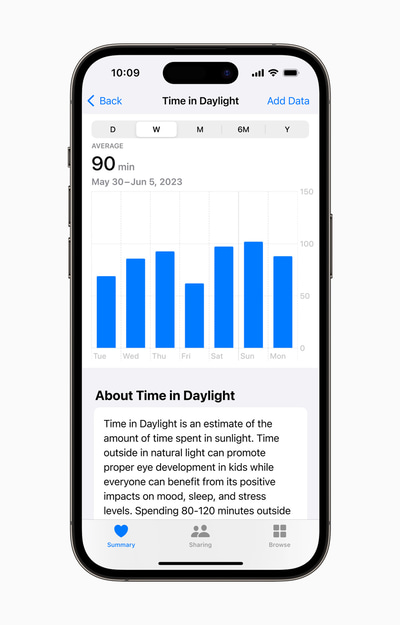- OT
- Industry
- Equipment and suppliers
- New Apple features put a spotlight on myopia
New Apple features put a spotlight on myopia
OT heard the view of a myopia management expert and tech-enthusiast on new tools that will measure time spent in daylight and remind users of screen distance

15 June 2023
Apple highlighted the scale of myopia, currently estimated to affect more than 30% of the global population and expected to grow to 50% by 2050.
The company pointed to guidance on helping to reduce the risk of myopia in children, such as the International Myopia Institute’s recommendation that children spend at least 80–120 minutes a day outdoors.

Using the ambient light sensor of their Apple Watch, users can view the amount of time spent in daylight in the Health app in iOS 17 and iPadOS 17.
Family Setup can be used to pair a child’s Apple Watch to their parent or guardian’s iPhone.
The company highlighted that, as time spent in daylight can have a variety of physical and mental health benefits, this feature is available to all watchOS 10 users.
Apple also pointed to recommendations of increasing viewing distances when using devices and books.
To support young device users to maintain a distance from their devices, the company has introduced the Screen Distance feature, using the TrueDepth camera that also operates Face ID.
If a user has been holding their device closer than 12 inches “for an extended period of time,” the feature will encourage users to move the screen further away.
These visual health features form part of a suite of health and wellbeing solutions that Apple is introducing.
Dr Sumbul Desai, Apple’s vice president of health, said the company wanted to “empower people to take charge of their own health journey,” adding: “Mental health and vision health are important, but often overlooked, and we’re excited to introduce features that offer valuable new insights to provide users with an even better understanding of their health.”
Desai suggested the features would aid users in daily decision-making, as well as supporting more informed conversations with health care professionals.
The features have the potential to make a big impact in educating and encouraging children to have good visual hygiene and be conscious of their own visual habits and risks
A view from practice with tech-enthusiast and optometrist Bhavin Shah
OT asked optometrist, Bhavin Shah, who provides myopia management services at his practice, Central Vision Opticians, and is a self-confessed “technophile,” for his view on the new features.
The announcement triggered an instant curiosity, Shah said: “I was very excited to hear about Apple’s announcement and employing features that may be simple to implement and execute, yet could have a powerful impact on children’s eyes.”
He added that he was particularly glad the tech giant had referred to the International Myopia Institute in its announcement.
“The features have the potential to make a big impact in educating and encouraging children to have good visual hygiene and be conscious of their own visual habits and risks,” Shah said, but cautioned that it would be important to emphasise that the features “are only part of the picture to encourage healthy behaviours.”
Considering the use of the features, he suggested: “It may only take a notification or nudge to remind a user to shift position or take a break.”
Healthy vision, healthy minds, healthy digital behaviours
“It is important to consider screen time as well as working distance and outdoor time,” he said, sharing a hope that there will be more features to come that can limit usage time.
The benefit of tools such as this could have applications in encouraging healthy habits for myopia management, and in additional areas of wellbeing.
“I think it is essential to have a conversation with the child, too, about the risks to vision and mental health, especially as children go into their teenage years and their mobile phone becomes an essential fixture,” he said.
“The objective of reducing screen time can often be contradictory to tech companies continuous need to increase the time and attention we give to their devices,” he acknowledged.
Asked about any further information that Shah would like to see around the technology, he shared that being able to see usage data of the tools, and perhaps data over time on the effectiveness of the features, would be helpful in order to have “some reassurance that these features are truly changing behaviours and not just gimmicks or marketing hype.”
“I hope it will garner interest from other technology companies to provide similar features, and also raise the topic in the media and press,” he added.
Shah did note, however, that while the company discussed these tools and their ambition to help reduce the risk of myopia through encouraging time outdoors and increasing screen distance, they have also this week announced a new augmented reality headset “that has 4K screens to be worn a few centimetres from the eyes.”
AOP members can find the AOP’s guidance on Myopia managing in clinical practice, online.
OT reached out to Apple for comment but has not received a response at the time of publication.
Advertisement


Comments (0)
You must be logged in to join the discussion. Log in